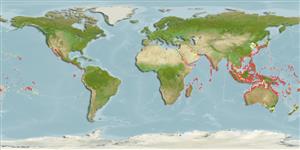Common names from other countries
>
Gonorynchiformes (Milkfishes) >
Chanidae (Milkfish)
Etymology: Chanos: Greek, chanos, -eos, ous, and chasma, -atos = abyss, mouth opened, inmensity (Ref. 45335).
Environment: milieu / climate zone / depth range / distribution range
بوم شناسي
دريايي; آب شيرين; لب شور موجوداتی که در محدوده وسیعی از آبهای آزاد از نزدیک بستر و یا روی کف بستر، در قسمت های میان آبی تا سطح آب و در برخی گونه ها با قابلیت پرواز، زندگی و تغذیه می کنند.; هردو رو (Ref. 51243); تغييرات عمق 1 - 30 m (Ref. 6898), usually ? - 15 m (Ref. 89972). Tropical; 15°C - 43°C (Ref. 43081); 46°N - 52°S, 19°E - 77°W
Indo-Pacific: along continental shelves and around islands, where temperatures are greater than 20°C. Red Sea and South Africa to Hawaii and the Marquesas, north to Japan, south to Victoria, Australia. Eastern Pacific: San Pedro, California to the Galapagos.
Length at first maturity / Size / Weight / سن
Maturity: Lm 86.1, range 68 - 70 cm
Max length : 180 cm SL جنس نر / بدون خواص جنسي; (Ref. 9710); 124.0 cm SL (female); common length : 100.0 cm SL جنس نر / بدون خواص جنسي; (Ref. 9814); بيشينه وزن گزارش شده: 14.0 kg (Ref. 9814); بيشينه سن گزارش شده: 15 سال ها (Ref. 9814)
خارهاي باله پشتي (کل) : 2; شعاع نرم باله پشتي (کل) : 13 - 17; خارهاي باله مخرجي: 2; شعاع نرم باله مخرجي: 8 - 10; مهره ها: 46. This species is characterized by the following: body elongate and somewhat compressed; mouth small and toothless; single dorsal about mid-level of the body; pectoral fins falcate; caudal fin large and deeply forked; no scutes on belly; branchiostegal rays 4. Colour of the body olive green dorsally; flanks silvery; unpaired fins with dark margins (Ref. 49, 117228).
Adults are found in offshore marine waters and shallow coastal embayments, but also frequently enter estuaries and occasionally penetrate freshwater streams (Ref. 44894, 52331). They occur in small to large schools near the coasts or around islands where reefs are well developed. Eggs and larvae are pelagic up to 2-3 weeks. Older larvae migrate onshore and settle in coastal wetlands (mangroves, estuaries) during the juvenile stage, or occasionally enter freshwater lakes. Juveniles and sub-adults return to sea where they mature sexually. Mature adults spawn only in fully saline water. Larvae eat zooplankton; juveniles and adults eat cyanobacteria, soft algae, small benthic invertebrates, and even pelagic fish eggs and larvae. Larvae are collected from rivers and are grown in culture ponds into juveniles which are marketed fresh, smoked, canned or frozen. Brood stocks can be raised and spawned in captivity to produce larvae in the hatchery (Ref. 12868). This species can thrive and grow in water as hot as 32° C (Ref. 9987).
Spawns in clear shallow waters above a bottom of sand or coral and at a distance of not more than 30 km from the shore. Females spawn up to 5 million eggs which hatch in about 24 hr. The larvae seek out clear coastal and estuarine waters warmer than 23°C with 10-32 salinity and abundant phytoplankton. Spawning and fertilization take place at night.
Bagarinao, T., 1994. Systematics, distribution, genetics and life history of milkfish, Chanos chanos. Environ. Biol. Fishes 39(1):23-41. (Ref. 9814)
وضعيت در فهرست قرمز IUCN (Ref. 130435)
CITES (Ref. 128078)
Not Evaluated
خطر برای انسان ها
Harmless
استفاده انسانی
ماهي گيري – شيلات: با ارزش تجاري بالا; آبزي پروري: تجاري; ماهي ها ي سرگرم كننده: بله; طعمه: usually
ابزارها
گزارش های ويژه
بارگيری XML
منابع اينترنتي
Estimates based on models
Preferred temperature (Ref.
115969): 20.7 - 29.2, mean 28.2 (based on 4182 cells).
Phylogenetic diversity index (Ref.
82804): PD
50 = 1.5000 [Uniqueness, from 0.5 = low to 2.0 = high].
Bayesian length-weight: a=0.00851 (0.00651 - 0.01113), b=3.06 (2.98 - 3.14), in cm Total Length, based on LWR estimates for this species (Ref.
93245).
Trophic level (Ref.
69278): 2.6 ±0.18 se; based on food items.
جهندگی (Ref.
120179): پايين ، كم, كمينه زمان لازم براي دو برابر شدن جمعيت 5/4 – 14 سال (tm=4-8; tmax=15; Fec=200,000).
Prior r = 0.28, 95% CL = 0.19 - 0.42, Based on 3 data-limited stock assessments.
Fishing Vulnerability (Ref.
59153): Very high vulnerability (90 of 100).
Climate Vulnerability (Ref.
125649): High to very high vulnerability (66 of 100).
